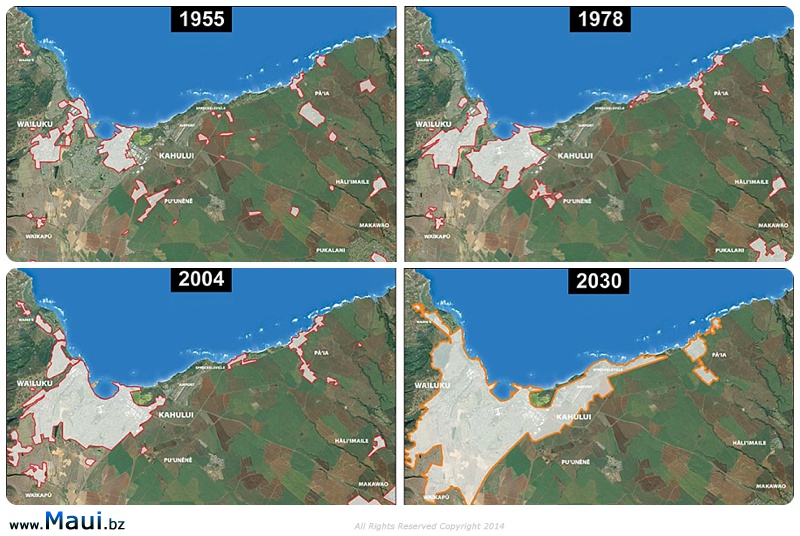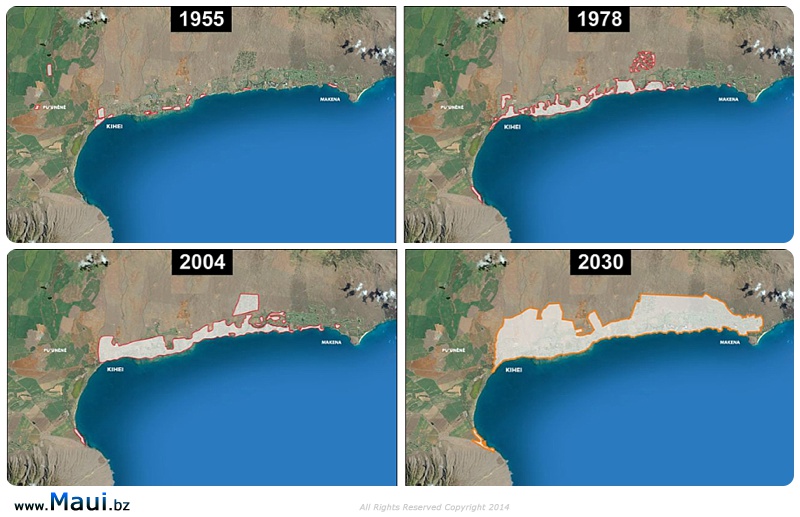One of the reasons locals and visitors alike fall in love with Maui is because it offers a small-town vibe while still being conveniently located to lots of restaurants, shops and nightlife. With the population and demand for housing growing daily, however, there is also a general opposition to urbanization and growth on the island, usually signifying more visitors, changing landscape, and a possible strain of resources, among other things. While growth is a necessary step to growing economies and providing employment opportunities, it will be interesting to see what steps Maui will take to accommodate or reject it.
Quick Facts (U.S. Census Bureau Projections):
- Between 2010 and 2030, Maui’s resident population is expected to grow from 144,444 to 194,630, an increase of 35%.
- The population is aging; the median age increased from 34.1 to 36.2 years between 1990 and 2000.
- Households are becoming smaller over time; Maui’s household size is projected to decline from 2.94 persons per household in 2000 to 2.66 persons per household in 2030.
- As of 2000, 53% of Maui’s population was born in Hawaii, 18% were born in another state and 29% were born in a foreign country. The percentage of Hawaii-born residents is expected to decrease due to high cost of living, limited employment and education opportunities and a desire to live outside of the state.
- In 1970, the ratio of tourists to residents was approximately 1 to 20. This number has risen dramatically; by 2030, the ratio is projected at 1 to 4.
Future Community Projections by Area (U.S. Census Bureau Projections):
- West Maui: Significant population and job growth; development potential for timeshares, large master-planned communities, and Hawaiian Homelands. Issue: while timeshares offer higher occupancy rates than hotels, they employ a smaller number of people.
- Kihei – Makena: Growth in the visitor industry, technology sector, and expanding residential areas; forecast shows stronger growth in residential units than visitor units.
- Wailuku – Kahului: Faster growth than other parts of Maui, as former sugar lands are developed into residential subdivisions; expected to maintain its status as home to more than a third of Maui’s households.
- Makawao – Pukalani – Kula: Economic growth will continue at a slower pace. With only 1 job located in this area for every 2.5 households, most of the area’s residents commute outside the area for work. This will continue to be the case; by 2030, the forecast shows only 2.1 local jobs per household.
- Paia – Haiku: Much slower growth in housing and population due to limited availability of suitable land for new homes.
- Hana: Slow growth is projected with new population resulting from in-migration; recent activity suggests job losses and fewer children and young adults.
Maui County General Plan:
- Goal: Maui’s people, values, and lifestyles thrive through strong, healthy, and vibrant island communities.
- Objective: Greater retention and return of island residents by providing viable work, education, and lifestyle options.
- Policies: Expand programs that enable the community to meet the education, employment, housing, and social goals of youth and young adults.
- Expand housing, transportation, employment, and social opportunities to ensure residents are able to comfortably age within their communities.
- Measure and track resident satisfaction through surveys and community indicators.
- Support funding for transportation, housing, health care, recreation, and social service programs that help those with special needs (including the elderly and disabled).
- Use an existing agency to facilitate education, employment, housing, social services, and other programs that help retain young adults on Maui.
- Identify existing and develop new funding sources for youth and family services (e.g., recreation, health care, education, housing, child care, etc.) and integrate such resources to achieve an effective outcome.
- Develop and regularly conduct a Community Satisfaction Survey to measure residents’ quality-of-life, facilitate the development of informed policies/programs, and improve service delivery.
Below are maps of historical growth patterns and projections for Central and South Maui, respectively, courtesy of Small Town Maui.


Sources:
https://www.olowalu.net/index.cfm?fuseaction=ig.page&PageID=157
https://www.olowalu.net/index.cfm?fuseaction=ig.page&PageID=163
https://www.smalltownmaui.org/
https://www.co.maui.hi.us/documents/17/69/71/3828/Chapter%201_201304191329387793.pdf

